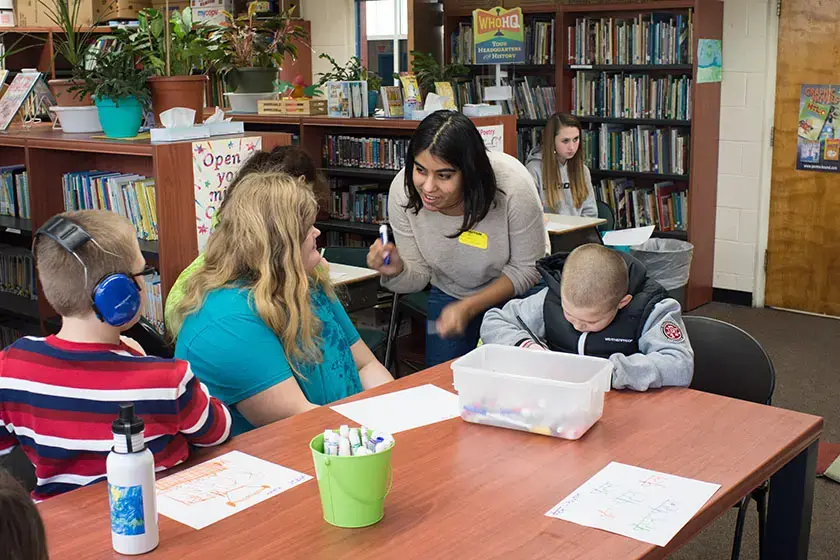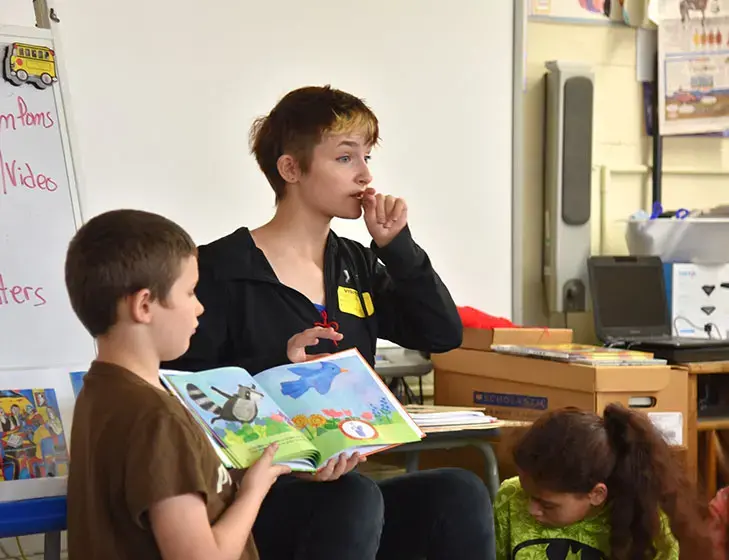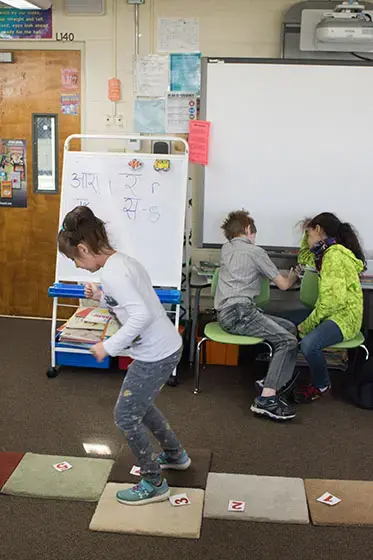Languages Across Levels
At Bennington College, students studying Languages have the opportunity to apply their studies in the broader Bennington community by teaching languages and cultures—including Chinese, French, Japanese, and Spanish—at Bennington Elementary and the Village School of North Bennington (VSNB).
This teaching opportunity is offered in conjunction with the biennial course Teaching Languages and Cultures K-6, led by faculty members Sarah Harris, Noëlle Rouxel-Cubberly, and Ikuko Yoshida. Bennington students receive teaching preparation and develop international culture lessons, which are designed with the support of Language faculty members.
French
Toby Lewkowicz ’19 studies Education, Web Design, and Social Justice at Bennington College and is currently teaching French to Kindergarteners at VSNB.
After studying French in middle and high school, Lewkowicz returned to the language at Bennington when he enrolled in Rouxel-Cubberly’s Chocolat course, which used the origins of the sweet as a springboard to exploring the cultural history surrounding chocolate.
“Studying chocolate’s origins quickly leads you to into the history of colonialism, slavery, cooking, and royalty. All these topics combined in the course,” said Lewkowicz. “There’s also a good amount of French film about chocolate, and we did a lot of interesting reading. And we did get to eat chocolate!”
Lewkowicz combined his love of teaching with his passion for French by teaching a fifth-grade class at Bennington Elementary.
“I had 24 students, so I quickly developed classroom management skills,” said Lewkowicz. “But it was a fantastic time.”
Lewkowicz focused his curriculum around the theme of “J’aime/I like.”
“Fifth graders want to be able to convey meaning, not just count to ten,” said Lewkowicz. “They want their knowledge to mean something, so I framed my class around things they like or don’t like, which gave them a way to build basic vocabulary through talking about how they felt.”
Lewkowicz also engaged multiple learning styles through interactive classroom activities.
“For one lesson, I talked about colors, painting, and the culture of art in France,” said Lewkowicz. “I gave everyone a black and white line art of Starry Night by Vincent Van Gogh and invited them to make their own Starry Night using any colors they wanted. It became a rainbow of everyone’s own perspectives of ‘What should this picture look like to me?’”
Japanese
Kameyo Okamoto ’19 studies Japanese and Education. Her experience learning the language and culture has also included rediscovering her family’s own history.
“My dad is Japanese, but his parents—my grandparents—had tried to separate themselves from the culture after living through World War II. My dad always felt distant from his own culture and the language because he never learned it,” said Okamoto. “I became interested in Japanese language and culture because it’s part of me, yet I knew nothing about it.”
To deepen her understanding, Okamoto studied abroad in Osaka, Japan, during her junior year.
“It was incredibly stressful being in an environment where you don’t know the language fully enough to express all of your thoughts and opinions in that one language,” she said of the challenge. “A lot of the general classes were taught in English, but our Japanese class was always taught in Japanese. However, I found that my listening comprehension increased tremendously.”
While abroad, Okamoto also enjoyed the opportunity to work at a Japanese elementary school, which helped inform how she is running her fourth-grade Japanese classes at Bennington Elementary.
“I watched the kids when the teachers left for lunch, and I stayed to talk to them in English or Japanese, depending on what they wanted to practice,” said Okamoto. “I’d notice how Japanese students are good at dealing with conflict in their inner groups of friends. Whenever there was a conflict, they collectively sorted it out, instead of going to the teacher. I’d only grown up in America so I’d never seen the Japanese education system, but that style of student problem solving was very different.”
As a language leader at Bennington, Okamoto also helps her peers practice their Japanese.
“When working within your own age group, I help with grammar and memorization techniques, which is different than teaching kids, whom you want to immerse in the language,” said Okamoto. “To an adult, I might say ‘赤 (aka) is red.’ But for a child, I would use the color itself as a guide, so they equate 赤 to the color, instead of to the word ‘red.’ Since their brains are still developing at a young age, they can make that connection directly instead of using English as an intermediary.”
Along with Okamoto, Steven Hendricks ’20 has also taught Japanese at Bennington Elementary. This term, he is helping his third-grade class envision life in Japan more clearly by setting his lessons in specific Japanese locations.
“My first lesson this year was about traveling to Japan,” said Hendricks. “We practiced Japanese words for the items you’d need to pack and ways you could to travel to the airport.” Coming lessons, said Hendricks, will be focused on the culture of four different cities: Sapporo, Tokyo, Kyoto, and Osaka.
Hendricks’s studies at Bennington are based in Media Studies and Psychology. He started studying Japanese because of his interest in the increasingly global tech market. While teaching isn’t a major focus of his Plan, he enjoys working with the kids and the fun challenge they provide.
“We have a two-sided laminated flag that has the American flag on one side and the Japanese flag on the other,” said Hendricks. “At the beginning of each class, we’ll hold up the American flag and do a countdown in English, then we flip to Japanese and stay in that language until the end of class. Then we’ll turn the flag around and see if they have any questions.”
Questions, said Hendricks, run the gamut from lesson nuances to “How do you say unicorn in Japanese?”
“They are a curious group, and it’s nice to know they are interested,” said Hendricks. “They are usually engaged with the lesson and willing to play along with the games.”
Chinese
Sherry Gao ’21 and Daniel Coelho ’19 teach Chinese to sixth graders at Village School of North Bennington.
Gao hails from China and wants to teach cross-culturally after graduation, either by teaching English in China or working at schools with an international student body.
“The biggest challenge of teaching sixth grade is that it requires a lot of energy, since sixth graders don’t always want to participate,” said Gao. “It helps to have rewards and plan engaging activities, as well as to have lots of enthusiasm yourself.”
As Gao and Coelho teach their Chinese language classes, they begin by working with students on the building blocks of the language.
“We’re encouraged to present our lessons in Chinese, but since the language is so different from English, the early lessons include using many gestures and facial expressions to make a point. It’s almost like charades,” said Gao.
“I feel like learning Chinese is a bit like learning chemistry: you have to understand the letters of the language as particles that need to go in a certain combination to be meaningful,” said Coelho, who studies Chinese along with Drama and French at Bennington. “Tones are also important in speaking Chinese. You start by learning syllables, and from that point on, you work on building vocabulary.”
Both Gao and Coelho enjoy faculty member Ginger Lin’s approach to teaching Chinese, which builds vocabulary through a broader framework of cultural studies and discussion.
“I liked Ginger’s Confucianism vs. Daoism course,” said Gao. “Even though I’m Chinese, I hadn’t known much about Confucianism before taking it.”
“Once you lay some groundwork studying Chinese, Ginger’s courses let you dig into huge themes, even from your second term with the language,” said Coelho. “We were learning words while also describing concepts like existentialism. I’d felt so paralyzed studying other languages, but you can make a lot of progress very quickly in Chinese.”
Coelho also encourages his peers at Bennington to take a chance on learning Chinese.
“I hope people see the fun of learning the language because the process should be fun,” said Coelho. “Globally, speaking Chinese is becoming an essential skill. I hope more people try it and find, like I did, that learning an Asiatic language is attainable, and there’s nothing that should limit you from trying.”
By Natalie Redmond, Associate Writer


